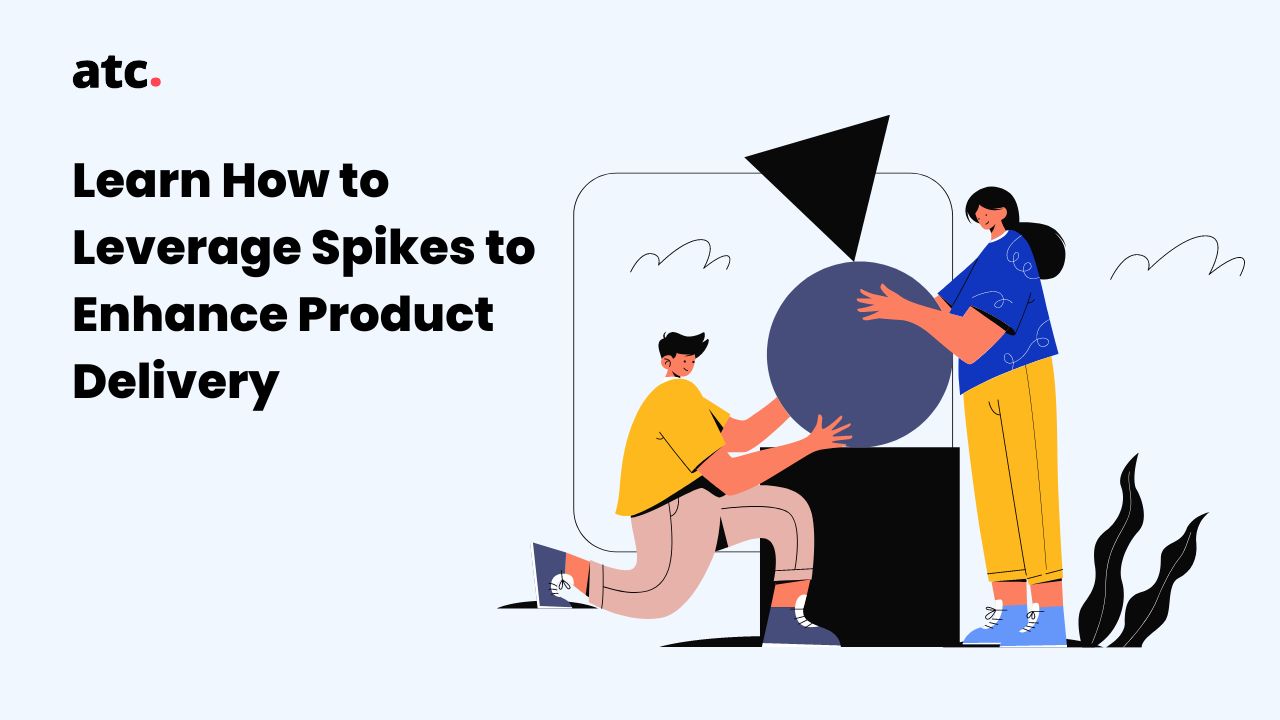Subscribe to the blog
Studies show that 87% of companies leverage Scrum for delivering complex development projects. And a crucial part of implementing Scrum is refining the product backlog.
It is a continuous process that involves reviewing, updating, and organizing each user story and priority task to ensure that it remains relevant and up-to-date. However, accurately estimating user stories requires additional research.
This is where spikes come in.
Spikes in Scrum is a time-boxed exploration of a technical problem or a specific question that helps the product owner and the development team uncover more information about a particular issue. The goal of the entire process is to provide a better understanding of the problem so they can make informed decisions and ensure that things remain on track.
In this guide, you will learn everything about Agile Spikes, how they work, their types, and their benefits to help you refine the product backlog and enhance product delivery.
How Do Spikes in Scrum Work?
Although most people think that spikes typically involve researching and experimenting with a technical or design problem, it has other use cases also. For instance, it can also help with prototyping or risk assessment.
Here are some scenarios where Agile teams may consider using spikes:
- Estimating new features and capabilities: User stories about new product features are critical for maintaining the product backlog. But estimating the time taken for developing the features can be difficult as there are many variables involved. With spikes, you can do additional research to determine a timeline.
- Determine the viability of epics: Spikes can help you perform a feasibility analysis to test the viability of epics and other related activities.
- Establish familiarity with a new technical domain: If your team is thinking about implementing a new development approach, it is imperative to research and find insights about it to achieve higher ROI.
- Reduce uncertainty: Delivering newer product features has certain risk aspects that the development team needs to consider. With spikes, the product owner can gather and analyze data to gain confidence and reduce uncertainty.
- Perform trial and error: If a development team is confused about a functional approach, performing trial and error can help the team better comprehend the concept.
Now that we have considered various use cases of spikes in Scrum. Let’s discover how you can make it work:
- Define the scope: Spikes are based on the three principles of Scrum- Inspection, transparency, and adaption. So having clear goals and objectives is critical. It includes what technical or design challenge you need to explore and what outcome you want.
- Set a timeline: Spikes are a time-boxed event. So Scrum teams must have a deadline to complete the event and present the outcome to the stakeholder. Typically, the entire event takes around 2-3 days.
- Inspect the problem: Conduct research, experimentation, or prototyping to gather information and address the issue.
- Track progress: Monitor the progress of the spike and ensure that it stays within the time box. If more time is needed, consider extending the time box or breaking the entire event into smaller chunks.
- Share the findings: The ultimate goal is to have a shared understanding of a problem. So presenting relevant insights is crucial. The information can help the team make informed decisions on how to proceed with the project.
What Are the Different Types of Spikes?
While teams can initiate spikes for in-depth solution research of any problem, there are two popular spike types.
- Technical Spikes
A technical spike focuses on investigating and experimenting with new technologies or solutions. The goal is to identify the best approach to solve a specific problem and estimate the effort required to implement it. They are ideal for projects that require adopting new technologies.
Here are some instances where you can use technical spikes in Scrum:
- Determining whether to opt for a SaaS solution or building it from scratch.
- Evaluating the potential impact of a new user story.
- Developing confidence about a technical approach.
- Identifying potential risks of integrating newer technical approaches with the product.
- Functional Spikes
Unlike technical spikes that help with the project’s technical aspects, functional spikes are concerned with improving the overall efficiency to reduce time-to-market. It involves gathering information, researching alternatives, and understanding the stakeholder's needs. They reduce ambiguity about the project and ensure that everything aligns with the business objectives.
Functional spikes can help the development team:
- Break down the project.
- Gain clarity about the project by organizing work.
- Identify and control risk elements.
- Use insights to influence implementation decisions and promote cross-functional collaboration.
- Estimate the time required to complete complex tasks and increase efficiency.
Differences Between Epics, User Stories, and Spikes
Epics, user stories, and spikes are the tools that help product owners, Scrum Masters, and the development team organize work and respond to changes. By understanding how these popular terms work, you can structure the entire project, right from the most critical objectives to the most minute detail.
Here is a list showcasing the differences between epics, user stories, and spikes to help you make an informed decision.
| Epics | User Stories | Spikes | |
| Scope | These are high-level user requirements that can be broken down into user stories. | These are short descriptions of a feature or functionality that provides value to the end user. | These involve researching user stories from a functional or technical aspect. |
| Perspective | They are user-focused. | They are typically written from the user's perspective and provide a clear understanding of what needs to be delivered. | They are not user-focussed. It revolves around addressing a design or technical challenge. |
| Duration | There is no designated period. It typically takes multiple iterations to complete epics in Agile. | It takes two to three weeks to complete user stories. | Spikes typically take 2-3 days to complete. |
Want to know more about how to estimate user stories? Read this guide to make Agile planning more flexible.
Best Practices For Using Agile Spikes
A concept adapted from Extreme Programming (XP), spikes are critical for product backlog refinement and accelerating the project’s pace. Here are the best practices you can follow while using Agile spikes.
- Demonstrate the results: The output of Spikes should provide visibility to your research and architectural efforts. It must build a shared understanding.
- It must seek to answer a single question: Spikes help find answers to a single, specific question rather than multiple questions or vague pieces of information. So if you want to explore different aspects, you need to split the spikes and address each of them individually.
- Evaluate the results: Once you have an outcome, you should document the results for future use. Determining what you have learned can help in future spikes and project decisions.
- Don’t use spikes only for technical problems: We have seen multiple use cases for spikes, but it is crucial to note that not all of them should focus on technical aspects. You can also use them to tackle design challenges.
- Identify and fill in gaps in product backlog: Spikes are crucial to identify gaps in the product backlog and capture new stories and ideas to reduce time to market.
Create a Successful Sprint Today!
Agile spikes can have a significant impact on the overall success of your sprint. They allow you to test new ideas, experiment with different approaches, and pivot quickly if necessary, creating a flexible and iterative development process. It also helps your team understand where they should spend their time and how to make progress on many competing priorities.
While spikes accelerate the product delivery pipeline, having a structured process is vital. And if you need help implementing Agile practices, we can help.
Our Scrum and SAFe training courses include training by industry experts to help your team gain knowledge about the best SAFe and Scrum concepts, processes, and tools.
Key features of our training programs:
- Immersive training format with live Q&A sessions and expert guidance.
- Highly vetted instructors with over 25 years of experience.
- Hands-on project-related support
- Designed per the latest industry trends with real-life examples and industry-driven case studies.
If you’d like, we can schedule a quick call to discuss more on this. Feel free to reach out here.
Frequently Asked Questions About Agile Spikes
What Are Agile Spikes?
Spike is a time-boxed exploration of a technical problem that helps the product owner uncover more information about a particular issue.
When to Use Spikes in Scrum?
You can use spikes to understand the viability of a user story, gain insights about a specific question or address an issue.
What is the difference between Agile Spike and Enabler?
Agile spikes are a type of enabler story that represents activities such as exploration, research, design, implementation, and prototyping. They both may look similar, but enablers usually have a broader scope.
How to Use Agile Spikes in Jira?
One of the benefits of spikes is that it is versatile and can be used across every Agile framework, including Scrum, SAFe, extreme programming (XP), and even Kanban. You can use the same steps to calculate spikes and track them in Jira.




